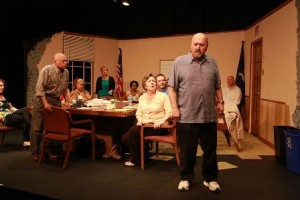Some plays are designed to whisk you away to a fantastical world, an alternate reality where folks spontaneously break into song. And then there are plays like 12 ANGRY JURORS, Chapel Street Players’ spring production: an ultra-realistic fly-on-the-wall reality play.
Originally set in 1956 and titled 12 ANGRY MEN, the once all-white, all male play has been updated to take place in the current day in Brooklyn, New York, with a diverse cast of men and women (as you would see on any urban jury today). There have been few changes to the powerful script, and though some details are less than current — there is no Death Penalty in New York, for example, and modern audiences might notice the lack of DNA evidence — the basics of the story and characters are timeless (sometimes unfortunately).

Susie Moak, Nicalia ThompSon, Pat Cullinane, Jeremy R. Smith, James Kendra in a scene from Chapel Street Players’
12 ANGRY JURORS.
The entire play is set in a jury room, around a long table littered with papers, cups and food containers. We don’t see the defendant, and the only glimpse of the lawyers, judge and courtroom is via a short video shot at the Wilmington Courthouse, shown at the beginning of the play. The entire opening segment, including the stage introduction of the characters, is cinematic in style. Once the music finishes and the “credits” have rolled, it’s more like being a spectator in a real jury room.
The twelve jurors are listed by number — to make it easier for the audience to keep track of the nameless characters, they’re seated in order by number around the table. As the Foreperson, Pat Cullinane plays an organized “den mother” type whose control starts to slip as the “open and shut” case for First Degree Murder begins to unravel.
The deliberation starts light, as the jurors expect to be home before dinnertime. They start with a vote, which could effectively end the deliberation right off the bat if it’s unanimous. Eleven of the jurors vote “Guilty”; only one, Juror 8, played thoughtfully by Susie Moak votes “Not Guilty.” Juror 8 explains that she can’t in good conscience send the Defendant to die (a Guilty verdict will lead to a mandatory death sentence) without discussing the case.
What follows is a sometimes manic, often emotional afternoon. Juror 3, played by a fiery Heather A. Stockwell, who is steadfast that the Defendant is guilty beyond a reasonable doubt, dominates the debate, along with the hot-headed (and more than a little bigoted) Juror 10, played by Patrick Sutton, and the cool and collected Juror 4, played by Brooks Black. As Juror 8 explains why the testimony does leave reasonable doubt in her opinion, the tide slowly starts to turn. As time goes on, other jurors open up, including the mild-mannered Juror 9, played by James Kendra; Gina Valania’s Juror 5, who relates to the Defendant’s rough upbringing; recent immigrant Juror 11, played by Nitin Mehta; and Pete Matthews, who, as Juror 7, spends part of the play seated with his back to the audience.
The roles require the actors to simply react (or not react) for periods of time without speaking. The actors are up to the challenge, though in some cases, especially with some of the things Juror 10 says — only Juror 9, a white male, reacts in anger to Juror 10’s declaration that “they” (the ethnicity of the Defendant is never specified) are all violent, out of control animals — the reactions seem dated. In the original play, when all of the jurors were white and male, there was a realism to that, but in this diverse production, the incendiary statements almost certainly applied directly to at least one of the other jurors, provoking at least a visual reaction.
Aside from such details, the update works well, and the actors are convincing in their roles as everyday strangers brought together to do their civic duty.
TWELVE ANGRY JURORS
by Sherman L. Sergel
Teleplay by Reginald Rose
Directed by Scott F. Mason
April 12 – 20, 2013
Chapel Street Players
27 N. Chapel Street
Newark, DE 19711
302-368-2248
http://chapelstreetplayers.org/





1 comment
One of the best community theater productions I have ever seen. All the actors and actresses are on point. Particular standouts are Brooks Black who plays her role exactly in the subtle understated fashion it was intended and Susie Moaks and Heather Stockwell are outstanding as an irresistable force vs an immovable object.
The criticism noted by the reviewer about it being unlikely in 2013 only one person would have objected to bigoted comment is of course correct. That is clearly a failing of the script not a failing of the off the chart performances and direction of everyone involved in this ambitious production.